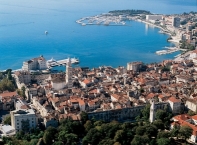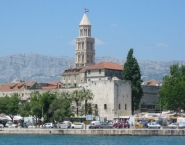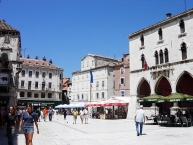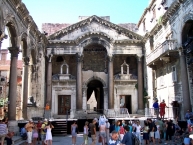Split
Worth visiting
Added on 11 Sep 2014,
last edited by biroto-Redaktion on 16 Jan 2017
Nearby cycle routes and tours
| Route name | Type | Dist. to route |
|---|---|---|
Route | 0,1 km | |
Route | 1,8 km | |
Tour | 0,2 km | |
Tour | 0,2 km |
![]()
Please wait - map data are loading
Type of sights
Old town / World heritage site
Name and address
Split
HR-21000 Split
GEO-data
Geodetic coordinates
43.50∎∎∎∎ 16.44∎∎∎∎
Elevation
17 m
Communication
Information about copyright | |
|---|---|
Rights owner | |
Rights characteristic / license | by-sa: CREATIVE COMMONS Attribution-ShareAlike |
Link to the description of the license | |
Image taken over from | |
Image has been uploaded | by biroto-Redaktion on 11 Sep 2014
|
Information about copyright | |
|---|---|
Rights owner | |
Rights characteristic / license | by-sa: CREATIVE COMMONS Attribution-ShareAlike |
Link to the description of the license | |
Image taken over from | |
Image has been uploaded | by biroto-Redaktion on 11 Sep 2014
|
Information about copyright | |
|---|---|
Rights owner | |
Rights characteristic / license | by-sa: CREATIVE COMMONS Attribution-ShareAlike |
Link to the description of the license | |
Image taken over from | |
Image has been uploaded | by biroto-Redaktion on 11 Sep 2014
|
Information about copyright | |
|---|---|
Rights owner | |
Rights characteristic / license | cc0: Public Domain no Rights reserved |
Link to the description of the license | |
Image taken over from | commons.wikimedia.org/wiki/File:Diocletians_mausoleum-Split.jpg |
Image has been uploaded | by biroto-Redaktion on 11 Sep 2014
|
Split is a city in Central Dalmatia, Croatia, and the seat of the Split-Dalmatia county. The city was originally built around the Diocletian palace (a palace/fort built for the retired Roman emperor Diocletian) where the locals sought refuge centuries ago. Wandering the historic centre of Split you can still clearly see the Roman walls, squares, and temples.
Understand
Because of its ideal climate, with 2,800 hours of sunlight each year, local people have a few nicknames for Split: "The most beautiful city in the world" and "Mediterranean flower". Many famous Croatian sports people were born in Split, so locals often nicknamed their city "The sportiest city in the world". The most popular sport institution is the football club Hajduk. Large portions of the city are painted with the club's colors and logo. This is done by Torcida, the oldest supporters group in Europe, established in 1950. Besides the bell tower of St. Duje, the symbols of city are the Dalmatian dog and a donkey. Locals have a high regard for the donkey because of its past indispensable place in field work and transport across the Dalmatian mountains.
Winters in Split are generally mild, with temperatures above 0°C, but despite the popular saying that the city experiences snowfall once every 30 years, there is actually at least one snowy day nearly every winter, usually in January or early February. If you find yourself in Split on a day with significant snowfall, expect serious traffic disruption.
See
Diocletian's Palace
UNESCO World Heritage site The historic centre of Split is built around the remains of this Roman palace. You only need to wander around to experience it but you can also pay to visit the excavated remains of the basement of the palace. The palace has well preserved main streets cardo and decumanus. Roman palace is enriched with some gothic and reinassance buildings which makes a perfect match. Palace has 4 monumental gates Porta Aurea (Zlatna vrata, Golden gate), Porta Argenta (Srebrna vrata, Silver gate), Porta Ferrea (Željezna vrata, Iron gate) and Porta Aenea (Mjedena vrata). It is probably the best preserved Roman palace in the world.
- ⊙Peristylium (Peristil square). Main square of Diocletian's palace with well preserved Roman architecture.
- ⊙Katedrala sv. Duje (St. Duje's cathedral). Originally built around 305 AD as a mausoleum of Roman emperor Diocletian's (the oldest cathedral building in the world). Cathedral is also a very beautiful mixture of Roman temple and Catholic church. It also has a beautiful belltower which provides you a great panoramic view of Split, nearby islands and Marjan hill.
- ⊙Jupiter temple (Cathedral's baptistry). Ancient Roman temple which became St. John's church. 5 Kn.
- ⊙Getski vrtal, Ul. Dominisova. is the smallest park in Split, situated in the Diocletian's palace at the Dominisova street (Marko Antonio De Dominis street). In that park are beautiful traditional Dalmatian tiramolas. During the summer these are full of clothes drying in the sunshine. In every guidebook about Split you have pictures from the Getski vrtal. It is the location of a 500 yr old stone house which was destroyed during World War II.
- Two original Egyptian sphinxes- One is located on Peristil square, and the other in front of Jupiter's temple or St. John's church. They were brought from Egypt by Roman emperor Diocletian.
Beyond the Diocletian's Palace
- Riva is the main city promenade. Since 2007. Riva has a new, modern appearance, which isn't up to the taste of some who used to it's authentic look.
- Marjan - a hill situated on the west of Split. Marjan is an oasis for many people who look for a natural stress relief, a great place for long walks, jogging, and bike rides. Marjan's peak, Telegrin is 174 m high and gives a wonderful panoramic view of Split. South cliffs are popular within alpine climbers. St. Nicholas church is situated on the east of Marjan, on its south side are beautiful St. Jeronimus church and "Gospe od Betlema" church (Madonna of Betlehem). House building is strictly forbidden in order to save Marjan - the lungs of Split.
- Varoš - one of the oldest parts of town. A place where lived most of the city peasants and fishermen. Charming streets and beautiful small houses.
- ⊙Galerija Meštrović. The gallery contains works of Ivan Meštrović, famous Croatian sculptor.
- ⊙Archaeological Museum. The oldest museum in Croatia (1820), about 20 min walk north of the old town (entry 20 kn). Many artifacts and monuments from Roman colonies Salona and Narona.
- Old graveyards. Sustipan and old Jewish cemetery
Useful
Inside the range of 4 km:
- ⊙ Tourist-Information Split, Split
Information about copyright | |
|---|---|
Rights characteristic / license | by-sa: CREATIVE COMMONS Attribution-ShareAlike |
Link to the description of the license | |
Input taken over from: |
Wikivoyage contributors, 'Split', Wikivoyage, The FREE worldwide travel guide that anyone can edit, 17 November 2016, 08:37 UTC, <https://en.wikivoyage.org/w/index.php?title=Split&oldid=3087800> [accessed 16 January 2017] |
taken over / edited on | 16 Jan 2017
|
taken over / edited by |
|
Nearby cycle routes and tours
| Route name | Type | Dist. to route |
|---|---|---|
Route | 0,1 km | |
Route | 1,8 km | |
Tour | 0,2 km | |
Tour | 0,2 km |
Added on 11 Sep 2014,
last edited by biroto-Redaktion on 16 Jan 2017




